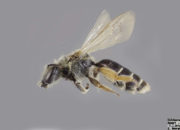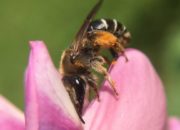From late May through July, this is one of the most apparent bees in many human-modified landscapes. It is native to Europe and has a strong preference for non-native legumes such as clover and vetch.
Identification: This is a moderately large and fairly distinctive mining bee. For the females, the combination of short hair on the thorax, orangish hairs on hind legs, and bold, incomplete hair bands on the abdomen should be distinctive, especially mid-summer when there are few other options.
Similar Species: Female Cresson’s Mining Bees (Andrena cressonii) and Hippotes’s Miner Bees (Andrena hippotes) are some of the most similar species, but are active earlier in the spring. Also compare the subgenus Lasioglossum.
Global Status: Not Ranked
Vermont Status: Introduced
For more information, visit the following links:
Discover Life
Living Atlas Species Page
Distribution: To see the global distribution, check out the iNaturalist account, and toggle the GBIF layer on the map.








